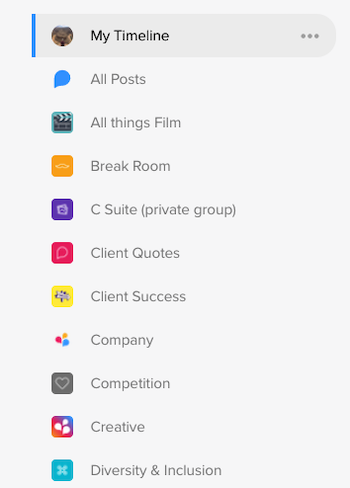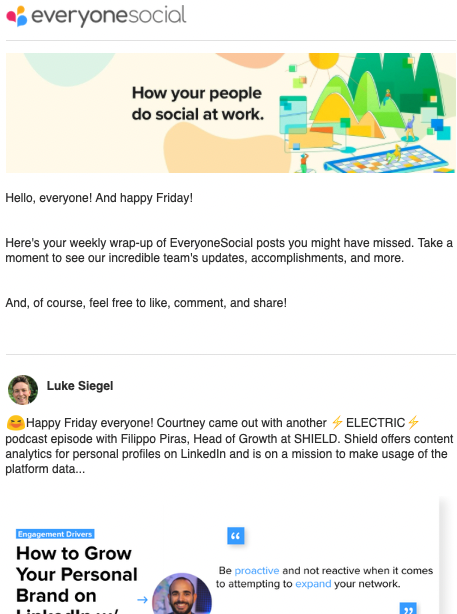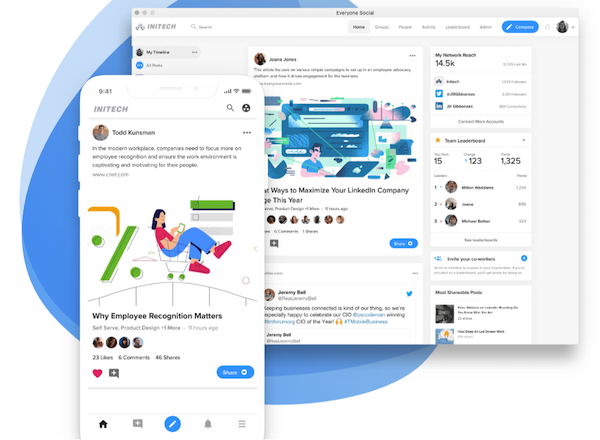Communication barriers have existed in business for decades and overcoming them should be a priority for any organization — especially in today’s technology-driven world.
The pandemic also caused a significant shift for many companies, a majority of which were not prepared and faced new challenges when it came to having a communications plan for global remote employees.
However, communication barriers existed even before the pandemic. In fact, 74% of employees feel they miss out on company information and news. In that same study, 85% of employees said they’re most motivated when management offers regular updates on company news.
So how does a modern organization identify communication barriers and overcome them? Let’s dive deeper into this topic and help your company get on the right track this year.
What Are Communication Barriers?
Communication barriers are anything within your organization that prevents people from receiving or understanding messages, ideas, and information. These barriers can also prevent messages from being sent effectively, causing a disconnect within the company.
When there is no identifiable plan (and solution!) for addressing these barriers, it starts to negatively impact multiple areas of the business. It trickles down from executives to managers and from managers to their teams.
Miscommunication can quickly create issues, leading to a negative impact on morale, productivity, employee engagement, trust, and revenue.
According to SHRM, “A survey of 400 companies with 100,000 employees each cited an average loss per company of $62.4 million per year because of inadequate communication to and between employees.”
Yikes!
3 Types Of Communication Barriers
Although there are plenty of communication barriers to address, there are three extremely common ones we want to address quickly. These might already be familiar to you, but they’re important for your company to understand.
1. Emotional barriers
Emotions that may create barriers to overall communications. Employees process things differently and may have a fear or social anxiety related to sharing or connecting.
2. Language barriers
This represents both verbal and nonverbal communication and can trigger barriers internally and globally.
3. Physical barriers
How accessible other employees and company leaders are can create communication barriers. Think remote work, desk-less employees, different offices, etc.
While these tend to be the big three that many organizations prioritize, there are other communication breakdowns happening, too.
Let’s look into some of the additional causes and how you can start to remove these barriers.
12 Additional Communication Barriers
It should be no surprise that organizations face more than a few communication barriers, but you may not initially realize these are other key areas you can work on.
4. Communication skills
Employees all have different skills and approaches to how they communicate. This can cause issues in how information is received or passed on based on an individual’s skills.
The challenge here is that most organizations don’t prioritize communications from a cultural level or on a performance-review level.
5. Hybrid work
Although remote work has been growing in popularity, the pandemic changed the way many companies do work.
Some businesses became completely remote indefinitely. Others now do hybrid work where some days may be employees are in an office setting, and other days they work from where they want.

This is great for company morale, but it can also create communication barriers as sometimes people are in close physical contact and other times they’re elsewhere and communication technology is needed.
6. Psychological
Another common barrier to communications is psychological, which can impact not only how people communicate, but also how they process information. Different factors can contribute to these barriers like stress, social anxiety, anger, and self-esteem.
These all play various roles in how willing and open employees are to share or how they take specific news or feedback.
7. Disengagement
Employee engagement may sound like an industry buzzword, but it is talked about so much because of the impact it has across organizations.
It impacts how well communications are sent and received. If one side is disengaged — or even both — communication will be negatively impacted.

If your company wants to become a modern workplace, then you’ll need an effective employee engagement action plan.
8. Organizational structure
Communication and information sharing can be broken due to the organizational structure of your company. This is often a barrier for larger companies because there are many hierarchies of managers and executives, plus outdated or confusing communication systems in place.
Information gets lost or miscommunicated, causing frustrations and misalignment on goals or work that needs to be completed.
9. Lack of trust
Nearly two-thirds (64%) of employees say trust has a direct impact on their sense of belonging at work, according to Business Wire. Yet, many organizations have trust issues on both sides of the business.
Employees want to be in the loop and feel open discussions are allowed, otherwise it can cause speculations and rumors that foster misinformation among teams.
10. Infrequent information
In our Employee Feedback Report, we surveyed customers over two years. One of the questions we asked was: “Do you feel that you have increased your learning related to work and your industry as a result of consuming relevant content?”
78% answered with “Yes!”
Your people want to be consistently informed about your company, through content that will make them more engaged and connected to their work. Too often communications are infrequent or inconsistent, driving employees to feel left in the dark and negatively impacting productivity.
11. Information overload
You might think that more information being shared at an increased frequency is the key to helping your communication barriers. Unfortunately, that can get your communications in more trouble.
Information overload occurs easily and creates a barrier because employees get annoyed and begin tuning information out. Plus, too much communication can become a distraction and stall productivity.
12. Lack of unified channel
People consume and communicate differently, which means your communications can start to get complicated.
You might have multiple channels for communicating or have people that prefer different ones, which can be confusing and time-consuming for your company.

If your company focuses too much on one channel, important information might be missed from those who are active elsewhere. It’s inevitable that you’ll have a few channels, but there are ways to streamline that from one central location, where the information can then hit most channels.
13. Cultural differences
Just like how people prefer different channels, everyone has different experiences and cultural views that affect how they like to be communicated with.
As a communicator or company leader, if you aren’t aware of the demographic and cultural backgrounds, barriers will quickly arise.

You’ll need to adapt and find a commonality among the organization to ensure communications reach everyone as appropriately as possible. It sounds tough, but being an effective communicator is not always as easy as people think!
14. Selective sharing
A potential communication barrier that may happen is selective sharing, which is when employees or leaders are not communicating the full-picture.
If you receive only a portion of news or messages, it breaks down the ability to do the work properly or distribute that important news to others. Again, this causes miscommunication and a distrust in the workplace.
15. No personalization
Too often, all communications are sent in an overly broad format. For example, it could be something related to sales teams that also gets sent to the engineering and product teams.
For the latter two groups, it’s not related to them at all. So they tune it out and over time they may start to ignore or dismiss all communications.
A pattern begins to emerge, which is why personalizing the communications and segmenting will create a better experience. One thing EveryoneSocial does is simplify this through the use of personalized feeds and groups, as illustrated below.

But there’s still the ability to share information with everyone if there’s a company-wide communication need.
Ways to Overcome Communications Barriers in the Workplace
To be an effective leader and a well-tuned company, communication and information distribution plays a major role in your organization’s long-term success.
There are a few ways you can overcome communication barriers that you have identified. But remember, you will never be able to overcome every barrier within communications.
Each employee is unique, has various perspectives, and interacts with others differently, so it’s an impossible feat to solve every communication challenge.
Instead, your goal should be to minimize the challenges as much as possible, make a clear effort, and find ways to streamline your communications.
1. Recognize generation gaps and differences
Not only will there be potential cultural differences and language barriers across your organization (depending on the size), you likely also have various generations of employees in the workforce.
Baby Boomers, Generation X, Millennials, and Generation Z are all beginning to work together more. Each of these groups have grown up and worked in very different environments, to say the least.
Each will have different preferences and expectations when it comes to communications, which means your company needs to have options to choose from. Understanding each generation’s needs will empower you to adapt communications appropriately and prevent barriers.
2. Gather feedback from your people around messaging
Since there are generational and cultural differences in your organization, an easy way to start figuring out how to distribute information effectively is to gather insights from employees.
Not everyone will answer your surveys or share their thoughts, but if you can get a good sample size it will help you understand what you must do better at.
It can be eye-opening to see where you thought your company was doing great, but is actually causing friction. Or to see things that you thought were struggling are actually working well for your people.
3. Develop consistency in communication effort
While there are multiple messages, communications, and information shared and discussed daily within your company, it’s the consistency that helps break down barriers.
Often, it’s to get excited and emphasize the importance of something and then in a few weeks, that tapers off. The consistency that was started becomes more sporadic or random, and the momentum is lost.
Like most things in life, results rarely appear overnight — they require effort and long-term consistency. This applies to communications and must be continued on a regular cadence.
4. Personalize information and messages
You might have noticed a theme here, but tailoring your messages, how they’re received, and how they’re sent is critical to connecting with everyone at your organization.
This means you need more personalized information that’s relevant to the right people, at the right time. You also have to deliver that information in the format people want — whether that’s audio, video, text, images (gifs, memes), etc.
While you can blast your entire internal database with an email, it’s not quite as simple as that. Plus, that causes employees to disengage or tune out the information.
So, to the best of your ability, personalize and segment information based on how your employees individually consume it.

EveryoneSocial, for example, has a feature that allows admins to send regular emails to employees that contain only content that each individual hasn’t yet engaged with, such as the example above.
5. Use technology and data to improve communication
Understanding the data around your communications is critical to finding gaps and seeing what is working well. Yet, too much technology can cause information overload and confusion of where to find the right content.
Your organization will inevitably have multiple communication tools, but you want to find a way to streamline it all in one simple way like EveryoneSocial does.

While Intranets, for example, have been a way to try and engage entire companies, in a survey, it was found only 13% of employees reported participating in their intranet daily. Thirty-one percent said they never do.
So what can you do? In the next section, we’ll dive into the technology side a bit further.
6. Encourage more two-way information sharing
Naturally, company leaders and managers distribute news or information quite often. However, communication is a company-wide need and information must flow from the top-level down and from the lower-levels up.
Not only should executives and managers be able to reach every employee or target audiences, but employees should also be able to effectively communicate info or needs to others.

Overall, it should be apparent to everyone that communication is valued and encouraged.
The Right Technology Improves Communication Barriers
It can be a tricky balance for organizations when it comes to technology. There are so many products and platforms to choose from and use that best fit your goals and company needs.
This is good from a communication standpoint as you have better ways to connect employees, no matter where they are in the world.
However, the challenge is when different divisions or locations of the company start implementing too many tools, many of which may have some overlapping features. Additionally, your leaders and comms teams might send other various forms of information differently.
While inevitably, every team, employee, and executive will have preferences for sharing and consuming — you can find ways to keep it simple and get everyone on the same page.
With the right technology, organizations can improve communication, engagement, and trust.
Here are some examples of what good communication tech can do:
- Easily distribute content, company news, and team updates
- Reach every employee, no matter where or how they work
- Segment information for more personalization
- Enable content and info delivery at optimal times
- Customize newsfeeds for employees based on their interests and needs
- Integrate with other important comms tools to reach people’s preferred channels
- Show the impact and reach of internal communications and engagement
- Analyze the information, data, and content that’s most engaging
- Make it easy for people to share ideas, interact with teammates, and build a rallying point for employees to build trust with each other
- Possess features that help the message reach employees in various ways: newsletter, push notifications, tagging, integrations to Slack and Microsoft Teams, etc.
Luckily, all the above (and more) can be done through an employee advocacy tool like EveryoneSocial.
If you want to see how employee communications and engagement can be improved — plus all the other additional benefits to marketing, sales, and employer branding — schedule your demo!















